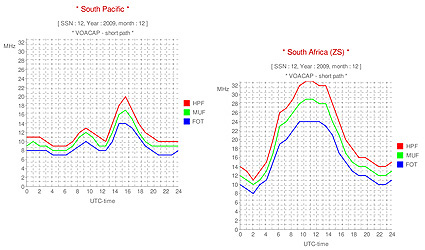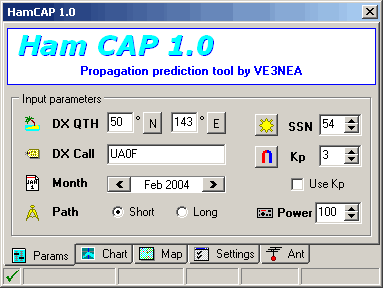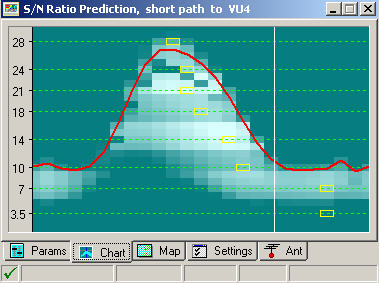
Propagatie
De HF-bakens van NCDXF en IARU
(21 december 2004, jd) Een zeer interessante "tool" voor het monitoren van de propagatie is het HF-bakensysteem op 10 tot en met 20m, dat bijna 30 jaar geleden het licht zag, het bakensysteem van NCDXF/IARU. Wil je er alles over weten, klik dan hier.
Klik hier voor de real time bakenlog van ON5AU.
De propagatievoorspellingen van de UBA

De UBA-propagatievoorspellingen worden dynamisch aangemaakt op basis van cijfergegevens die opgeslagen zijn in een database. Het is Danny ON8DS die ervoor gezorgd heeft dat het aanmaken van de propagatiegrafieken geautomatiseerd werd. Klik hier om de gegevens van deze maand te bekijken. Vanuit de interface kan je ook de grafieken van de volgende (en vorige) maanden bekijken (voor zover de gegevens reeds beschikbaar zijn in de database).
Voor detailuitleg over deze grafieken, klik hier
De 3 gekleurde lijnen op de grafieken stellen voor:
| HPF | Highest Possible Frequency: op 10% van de dagen zal er propagatie zijn op de frequenties door deze lijn aangegeven |
| MUF | Maxium Usable Frequency: op 50% van de dagen zal er propagatie zijn op de frequenties door deze lijn aangegeven |
| FOT | Frequency Optimal Traffic: op 90% van de dagen zal er propagatie zijn op de frequenties door deze lijn aangegeven |
De gegevens voor het opmaken van de UBA propagatie-forecast grafieken zijn gegenereerd d.m.v. VOACAP. De voorspellingen zijn gebaseerd op de laatste prognoses van het SSN (Smoothed Sunspot Number). Alle berekeningen zijn gedaan voor België, en gelden voor "short path".
Smoothed Sunspot Number
When the daily sunspot count is plotted over a month's time, the graph is very spiky. Averaging daily sunspot numbers over a month results in the monthly average sunspot number, however it also results in a spiky plot. A smoother plot is desired by researchers. To get that, they choose a more averaged, or smoothed, measurement to measure solar cycles. This is the so-called smoothed sunspot number (SSN) calculated across five and a half months of data before and after a desired month, plus the data for the desired month. The amount of smoothing leaves the official SSN a half year behind the current month.

The above graphics (source: Sunspot Index Data Center in Brussels), represent solar cycles 22-23. The red line is the monthly smoothed sunspot number while the blue line is the actual monthly sunspot number. Cycle 22 started in September 1986 at 12.3. Cycle 23 started in May 1996 with the monthly SSN at 8.0 and peaked in April 2000 at 120.8.
How to get the correct SSN? (contributed by ON4SKY)
SSN calculation is based on the Lincoln-McNish smoothing function. George Lane, one of the main VOACAP developers, recommends to use the SSN listed at NGDC FTP website because other SSNs are supposed to give erroneous results. For the small story, only the NGDC's SSN has been used to calibrate the predictions from VOACAP, hence George's recommendation. HFradio.org have well understood the message and suggests to all readers searching for archive and data approved for research to connect on NGDC website. They provide however the "Predicted SSN" interpolated by IPS Radio Space Services, Australia, like do SEC... but the SSN provided does not match what IPS called "SSN"! (see table below). In addition, HFradio.org provide data from various observatories for readers whishing to get an overview of the current solar and spaceweather status or general forecasts. But they state also that "forecasting is an inexact science"...
SSN: current, predicted, equivalent, effective...
| NGDC: | Predicted SSN = 41.7 (the only one source for VOACAP) |
| IPS: | SSN = 44.4 |
| SEC: | Predicted SSN = 33.6 (stated from IPS) |
| HFradio.org: | Predicted SSN = 33.6 (stated from IPS) |
| GeoAlert-Extreme: | Equivalent SSN = 31 (stated from SEC) |
| WinCAP Wizard3: | SSN = 34 (stated from SEC) |
| DX ToolBox: | SSN = 36 (in fact calculated for August 29) |
| IonoProbe: |
Current SSN = 36 (in fact the Sunspot number for Aug 30) Effective SSN = 89 (from real-time interpolation) |
| HFProp: | SSN = 29 |
|
Some "SSN" and assimilated values predicted or calculated for "August 2004" compiled from various observatories and applications on August 30 at 16h30 UTC. Note that sunspot number (close to the SSN value but lower), RI and other ISN are different thing than SSN, therefore I haven't list them to avoid still more confusion in your mind, Hi!
|
|
SEC/NOAA maintains also SSN indices which numbers are slightly different from the one published by NGDC. Between both sites the " SSN" difference reaches 60%... SSN published by SEC are (unfortunately) used by many VOACAP-based applications, to name WinCAP Wizard 3 (even though, its value is different, see the above table), hence the belief that SEC provided the SSN for VOACAP.
As you understood, nobody predicts the same SSN as NGDC! Theoretically SSN represents predictions for what we call the "predicted SSN" or SSN. The smoothing is usually over time periods of about 6 months to one year or more so both the daily and the monthly values for the sunspot number as displayed at Spaceweather.com will always fluctuate around predicted numbers. But stop here because RI and other ISN are still other indices to not confuse with SSN.
If during periods of low sun activity these median values don't differ much from one site to another or in relation to the real values, during the period of sun paroxysm, these averages can be very different from the daily real values. So, whatever the improvement made on the VOACAP engine of your application, to get better propagation forecasts, always run the simulation with values up to 20% higher and lower than the SNN to see what happens. Your DX coverage can vary from 10 to 25%!
At last, as you noted, VOACAP doesn't provide any connexion to the Internet to update automatically these fields or to use the system date. Hopefully other interfaces solved this problem to name WinCAP Wizard 3 that calls GeoAlert-Extreme Wizard or DXAtlas that calls IonoProbe to retrieve the monthly update.
The SSN or the solar flux at 10.7 cm (F10.7) is the main factor to consider when calculating the propagation for a band. The sun activity (radiation pressure) is not without effects on the ionization of ionospheric layers but also on the temperature and pressure of the high atmosphere of the Earth.
This second effect mainly affects the lowest band propagation, a factor too rarely considered in propagation programs that ignore the weather conditions as well as other factors (e.g. Appleton's magneto-ionic theory), and VOACAP doesn't go against the rule.
For example, there is no input in VOACAP for the geomagnetic field, A- or K-indices despite their utility to detect a possible geomagnetic disturbance or a storm. This can be a problem if you want to work via the north pole, during auroral activities, or on the top band, to establish short-term forecasts, or when working with vertical antennas at low latitudes. Here also, more recent applications developed new methods to bypass this problem, using for example real-time ionosondes (e.g. DXAtlas).
The predicted Smoothed Sunspot numbers according to the NGDC FTP website are:
| YEAR | JAN | FEB | MAR | APR | MAY | JUN | JUL | AUG | SEP | OCT | NOV | DEC |
| 2009 | 10.4 | 12.0 | 13.7 | 15.7 | 18.1 | 20.6 | 23.3 | 26.3 | 29.3 | 32.8 | 36.7 | 40.4 |
Maak nu je eigen voorspellingen
|
VE3NEA, de auteur van onder andere DX Atlas, heeft VOACAP dermate verwerkt in een eigen programma, dat het zo moeilijke Voacap programma nu toegankelijk is voor iedereen.
Je dient alleen je eigen ligging in te brengen, de call of de prefix van de andere kant van het pad, de antennes die je gebruikt, en klaar is kees.
In enkele seconden zal het programma onder andere je een mooie curve tekenen waarop ook de MUF-lijn staat en waar je makkelijk kan uit afleiden op welke tijd van de dag er mogelijke propagatie is.
Je kan deze freeware hier downloaden. |
 |
Andere sites over HF propagatie
 |
Alles over propagatie nu |
| Propagation forecasts | |
| Current conditions | |
| Website ON5AU | |
| Website ON4AA | |
| Dourbes Digisond |


